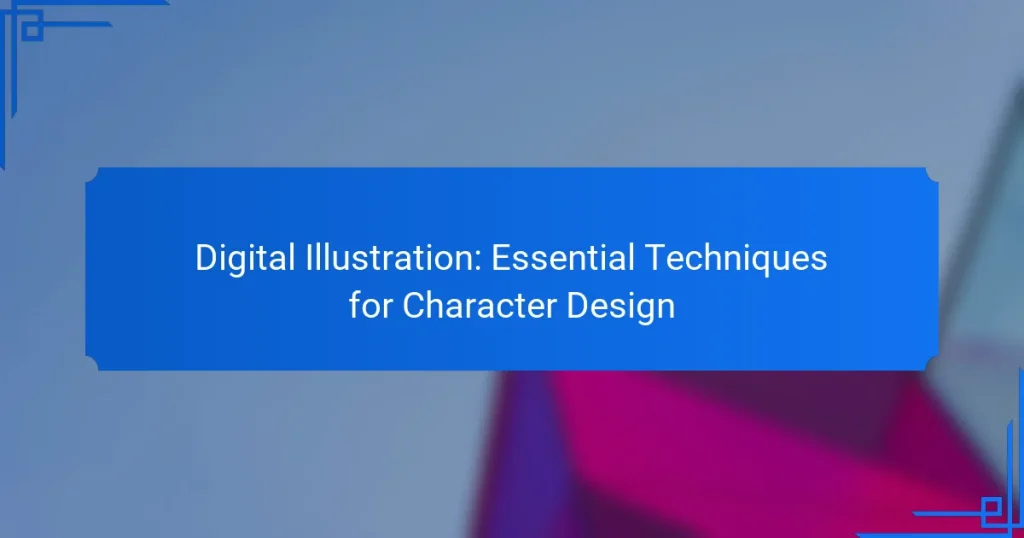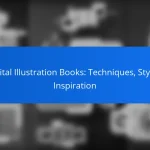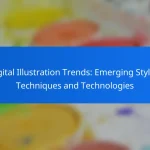Digital illustration offers a dynamic platform for character design, where mastering essential techniques can elevate your creations. Key skills such as sketching fundamentals, color theory, and understanding anatomy are vital for crafting characters that truly resonate. Selecting the right software tailored to your artistic style and needs further enhances your ability to bring these characters to life. By blending creativity with structured development processes, you can significantly improve the quality and appeal of your designs.

What Are the Essential Techniques for Character Design?
Essential techniques for character design include mastering sketching fundamentals, applying color theory, understanding proportions and anatomy, utilizing digital tools, and exploring different styles. These techniques help create compelling and visually appealing characters that resonate with audiences.
Sketching Fundamentals
Sketching is the foundation of character design, allowing artists to visualize ideas quickly. Start with basic shapes to outline the character’s form and gradually add details. Focus on gesture drawing to capture movement and personality.
Practice regularly to improve your sketching skills. Use references from real life or other artworks to understand different poses and expressions. Keep your sketches loose and fluid to encourage creativity.
Color Theory Application
Color theory is crucial in character design as it influences mood and perception. Understand the color wheel, including primary, secondary, and tertiary colors, to create harmonious palettes. Use complementary colors for contrast and analogous colors for a cohesive look.
Experiment with color combinations to see how they affect the character’s personality. For instance, warm colors like red and orange can evoke energy, while cool colors like blue and green can convey calmness. Consider the cultural meanings of colors as well.
Proportions and Anatomy
Understanding proportions and anatomy is vital for creating believable characters. Familiarize yourself with the human figure’s basic proportions, such as the head-to-body ratio, which typically ranges from 1:7 to 1:8 for adults. Adjust these ratios for stylized characters.
Study anatomy to know how muscles and bones affect movement and posture. Use anatomical references to ensure accuracy, especially for dynamic poses. Remember that exaggeration can enhance character design, but it should still be grounded in realism.
Digital Tools Overview
Digital tools have transformed character design, offering various software options like Adobe Photoshop, Procreate, and Clip Studio Paint. Each tool has unique features, so choose one that aligns with your workflow and style preferences.
Familiarize yourself with essential functions such as layers, brushes, and blending modes. Utilize shortcuts to speed up your process and explore plugins that can enhance your design capabilities. Regularly update your software to access new features and improvements.
Style Exploration
Exploring different styles is essential for developing a unique character design approach. Study various artistic movements, from realism to cartoon, to understand their characteristics and techniques. This exploration can inspire your own style.
Experiment with combining elements from different styles to create something original. Keep a sketchbook to document your ideas and variations. Seek feedback from peers or online communities to refine your designs and discover new perspectives.
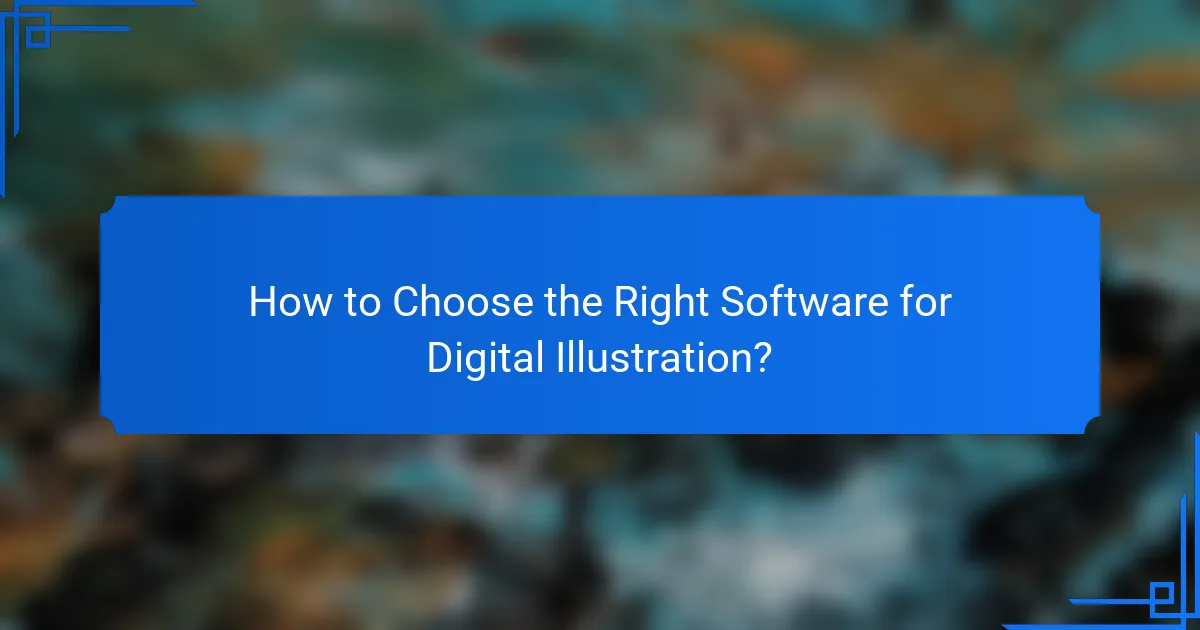
How to Choose the Right Software for Digital Illustration?
Selecting the right software for digital illustration is crucial for effective character design. Consider factors such as your artistic style, budget, and the specific features you need to bring your characters to life.
Adobe Illustrator Features
Adobe Illustrator is renowned for its vector-based capabilities, making it ideal for creating scalable character designs without loss of quality. Key features include advanced pen tools, a wide range of brushes, and the ability to work with layers, which allows for detailed and organized artwork.
Additionally, Illustrator supports integration with other Adobe products, enhancing workflow efficiency. For example, you can easily import assets from Photoshop or After Effects, streamlining your character design process.
Procreate Advantages
Procreate is a favorite among illustrators for its intuitive interface and powerful brush engine, providing a natural drawing experience on iPad. It offers a vast library of customizable brushes and tools, allowing artists to experiment with different styles and techniques.
One of Procreate’s standout features is its ability to record your drawing process, which can be useful for tutorials or sharing your techniques. The app is also relatively affordable, making it accessible for both beginners and professionals.
Clip Studio Paint Capabilities
Clip Studio Paint excels in character design, particularly for manga and comic artists. It includes specialized tools for inking, coloring, and creating 3D models, which can be a significant advantage when designing complex characters.
The software offers a flexible pricing model, with options for one-time purchases or subscriptions, catering to different budgets. Its extensive community and resources provide valuable support for users looking to enhance their skills in character illustration.

What Are the Best Practices for Character Concept Development?
Effective character concept development involves a blend of creativity and structured techniques. Prioritizing research, sketching, and iterative feedback can significantly enhance the quality of your character designs.
Research and Inspiration Gathering
Gathering research and inspiration is crucial for character concept development. Start by exploring various sources such as art books, films, and online platforms like Pinterest or ArtStation. This helps in understanding different styles and character archetypes.
Consider creating a mood board that combines images, colors, and textures that resonate with your character’s personality and story. This visual reference can guide your design choices and ensure consistency throughout the development process.
Thumbnail Sketching Techniques
Thumbnail sketching is an essential step in visualizing character concepts quickly. Create small, rough sketches to explore different poses, proportions, and features without committing to details. Aim for a variety of designs, focusing on silhouette and overall shape.
Limit your thumbnail sketches to a few minutes each to encourage spontaneity and creativity. Once you have a range of thumbnails, select the most promising ones to develop further into more detailed sketches.
Feedback and Iteration Process
Incorporating feedback is vital for refining character designs. Share your sketches with peers or mentors to gain diverse perspectives. Constructive criticism can highlight areas for improvement that you might overlook.
Iterate on your designs based on the feedback received. Make adjustments to elements like color, shape, and expression. This process may require several rounds of revisions, but it ultimately leads to a stronger and more engaging character design.

How to Create Unique Character Designs?
Creating unique character designs involves blending creativity with specific techniques that highlight individuality. Focus on personal style, cultural influences, and the integration of various art styles to develop characters that stand out.
Incorporating Personal Style
Incorporating personal style into character design means reflecting your artistic preferences and experiences. This can include signature color palettes, line work, or specific character traits that resonate with your identity as an artist.
To effectively incorporate your style, consider creating a mood board that showcases elements you love. This can guide your design choices and ensure consistency across your characters.
Using Cultural References
Using cultural references enriches character designs by adding depth and relatability. Drawing from various cultures can inspire unique clothing, accessories, and backstories that resonate with diverse audiences.
When using cultural elements, ensure respectful representation. Research the cultural significance of symbols or attire to avoid stereotypes and misinterpretations. This approach not only enhances authenticity but also fosters appreciation for different cultures.
Mixing Different Art Styles
Mixing different art styles can create visually striking character designs that capture attention. Combining elements from styles such as realism, cartoon, or abstract can result in a unique aesthetic that sets your work apart.
Experiment with blending techniques by sketching characters in one style and coloring them in another. This can lead to innovative designs that maintain the strengths of each style while creating something entirely new.
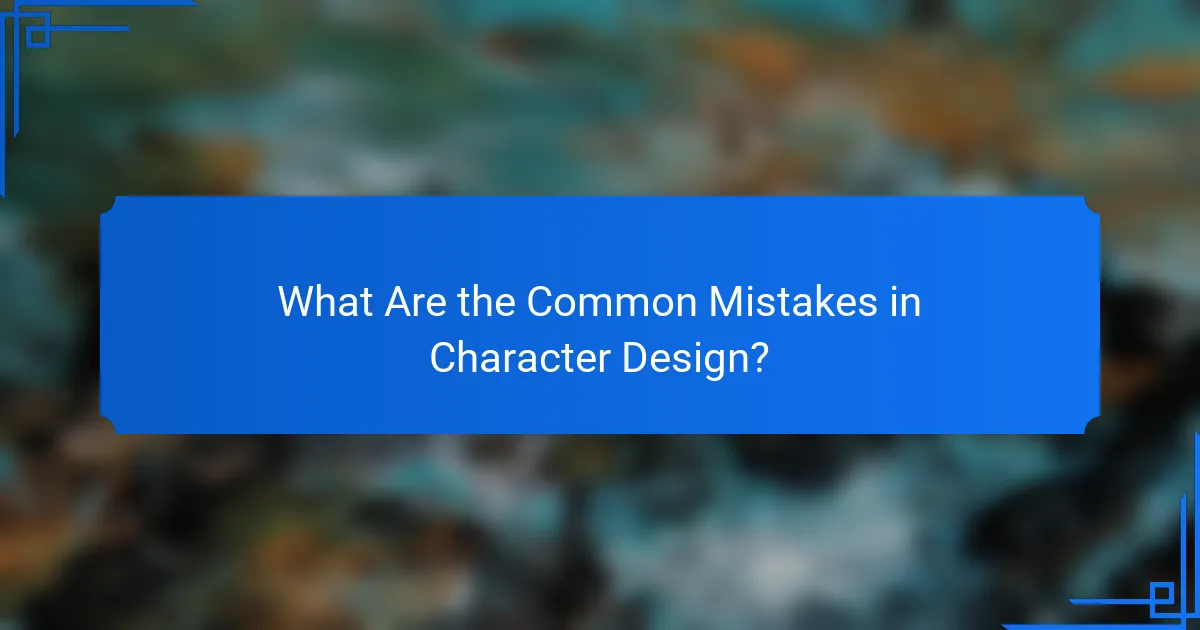
What Are the Common Mistakes in Character Design?
Common mistakes in character design often stem from a lack of understanding of anatomy and an inclination to create overly complex designs. These pitfalls can hinder the effectiveness and appeal of a character, making it difficult for audiences to connect with them.
Ignoring Anatomy Basics
Ignoring the fundamentals of anatomy can lead to unrealistic and unrelatable characters. Understanding human and animal proportions, muscle structure, and movement is crucial for creating believable designs. For instance, characters with exaggerated features may look interesting but can appear awkward if the underlying anatomy is flawed.
To avoid this mistake, study anatomy through reference images or life drawing sessions. Focus on key aspects like the skeletal structure and muscle groups to enhance your character’s realism. A good rule of thumb is to ensure that limbs and facial features maintain proportional relationships to one another.
Overcomplicating Designs
Overcomplicating character designs can detract from their visual impact and make them harder to animate or reproduce. While intricate details can be appealing, they may overwhelm the viewer or obscure the character’s personality. Aim for a balance between simplicity and detail to maintain clarity.
To simplify designs, focus on essential features that convey the character’s traits effectively. Use a limited color palette and avoid excessive patterns or accessories. A practical approach is to create a silhouette that is recognizable and distinctive, ensuring that the character stands out even in a simplified form.
